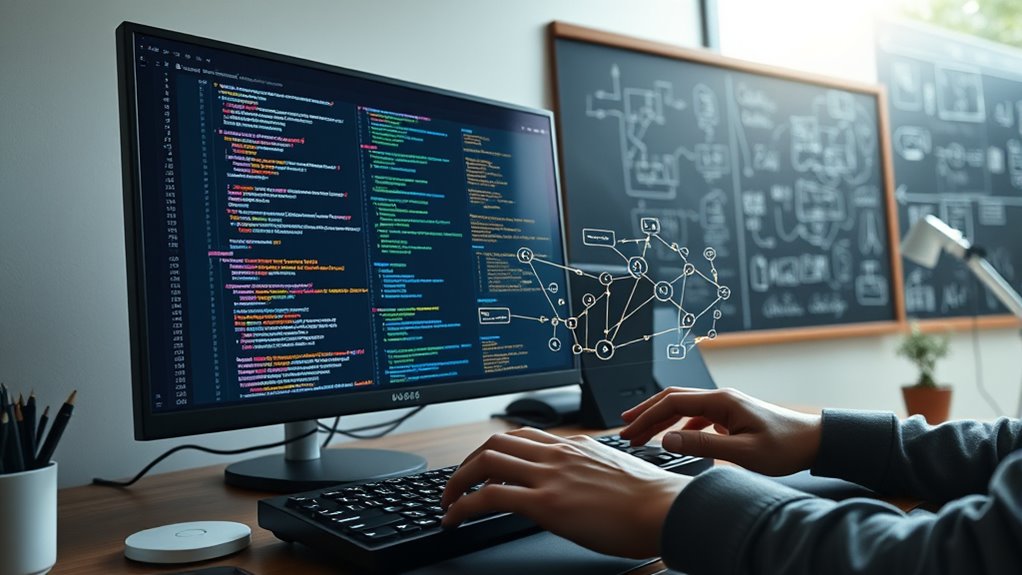To start integrating AI into your coding workflow, begin by using AI-powered code editors or IDE plugins that offer intelligent autocomplete and real-time error detection. These tools help you catch mistakes early and speed up development. Explore debugging tools that analyze code and suggest fixes, reducing your debugging time. Automate repetitive tasks like formatting and testing to focus on creative work. Keep experimenting with new AI features, and you’ll discover more ways to improve your coding efficiency.
Key Takeaways
- Start by integrating AI-powered code editors or IDE plugins that offer intelligent code completion and real-time error detection.
- Utilize AI debugging tools to analyze your code, identify issues, and receive suggested fixes to improve code quality.
- Automate repetitive tasks like formatting, testing, and deploying using AI-driven automation features within your development environment.
- Learn from available AI code snippets and boilerplate generators to accelerate feature development and reduce manual coding effort.
- Gradually incorporate AI suggestions and tools into your workflow, focusing on enhancing productivity, accuracy, and sustainable coding practices.

Integrating AI into your coding workflow can substantially boost productivity and streamline complex tasks. As a beginner, you might wonder how AI can fit into your daily development process, but the truth is, AI tools are designed to make coding more efficient and less error-prone. One of the key areas where AI makes a significant impact is AI debugging. Instead of manually searching through logs or trying to replicate bugs, AI-powered debugging tools analyze your code in real-time, identify potential issues, and suggest fixes. These tools use machine learning algorithms to recognize patterns and common error types, allowing you to quickly locate and resolve problems. This not only saves you hours of frustration but also improves the overall stability of your code.
Code automation is another essential benefit AI brings to your workflow. By automating repetitive tasks such as code formatting, testing, or deploying, you free up your time to focus on more creative and challenging aspects of programming. AI-driven code automation tools can generate boilerplate code, optimize functions, or even suggest code snippets based on your project context. For example, if you’re working on a web app, an AI assistant might automatically generate the necessary boilerplate for a new feature or suggest improvements to your existing codebase. These tools learn from vast amounts of code data, so their suggestions become more accurate and helpful over time. Additionally, integrating AI-enhanced code review can help catch subtle bugs and improve code quality before deployment.
Getting started with AI in your workflow is straightforward. You can begin by integrating AI-powered code editors or IDE plugins that offer features like intelligent code completion, real-time error detection, and automatic refactoring suggestions. Many popular IDEs now support AI extensions that analyze your code as you write, offering contextual suggestions that speed up development without sacrificing quality. As you grow more comfortable, explore specialized AI debugging tools that can scan your entire codebase for hidden bugs or performance bottlenecks and propose effective solutions. Furthermore, understanding how environmental considerations like energy efficiency and resource management can be integrated into development practices encourages more sustainable coding habits. Additionally, automation in logistics and inventory management from recent industry advancements demonstrates how AI can handle large-scale data effectively, which can inspire developers to utilize AI for managing complex project data more efficiently.
Frequently Asked Questions
What Are the Best AI Tools for Novice Programmers?
As a novice programmer, you should explore AI tools that focus on code automation and debugging assistance. Tools like GitHub Copilot help you write code faster by suggesting snippets, while DeepCode provides debugging support to catch errors early. These tools simplify complex tasks, improve your coding efficiency, and boost confidence. By integrating them into your workflow, you’ll learn faster and become more proficient in coding with AI’s helpful support.
How Do I Ensure AI Integration Maintains Code Security?
You might wonder if integrating AI affects your code security, and research shows that proper measures can mitigate risks. To guarantee security, prioritize data privacy by encrypting sensitive data and implement strict access controls to limit who can modify or view AI components. Regularly update your security protocols, monitor AI activity for irregularities, and use trusted AI tools. This way, you keep your code safe while benefiting from AI integration.
Can AI Replace Human Developers Entirely?
You might wonder if AI can replace human developers entirely, but while AI has significant automation potential, it still faces creative limitations. AI can handle repetitive tasks and assist with coding, but it lacks the nuanced understanding, problem-solving skills, and creativity humans bring. So, instead of replacing you, AI acts as a powerful tool to enhance your productivity and focus on more innovative aspects of development.
What Are Common Pitfalls When Implementing AI in Coding?
It’s a coincidence that many developers face common mistakes when implementing AI in coding, often due to integration challenges. You might overlook data quality, underestimate the importance of continuous training, or rely too heavily on AI tools without proper oversight. These pitfalls can hinder your progress. To succeed, stay vigilant about testing, validate outputs regularly, and guarantee your team understands AI’s limitations, avoiding common mistakes that could slow your workflow.
How Do I Measure Ai’S Impact on My Workflow Efficiency?
To measure AI’s impact on your workflow efficiency, focus on productivity metrics like code completion time, error rates, and task turnaround. Set clear workflow benchmarks before AI integration, then track changes over time. Use tools like time tracking or version control to compare performance pre- and post-AI. This way, you gain insights into AI’s contribution and can optimize its use to boost your overall coding productivity.
Conclusion
By embracing AI in your coding journey, you’re stepping into a new era of innovation—think of it as wielding a modern Excalibur, transforming your workflow from ordinary to extraordinary. As you continue to explore and adapt, remember that even Merlin needed a moment to master magic. Stay curious, keep experimenting, and soon AI will become your most powerful tool, guiding you toward coding mastery like a trusted wizard in the digital age.









